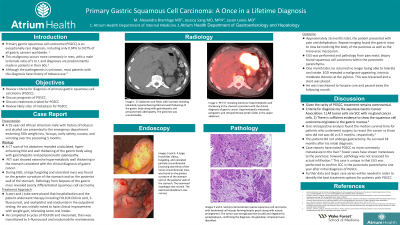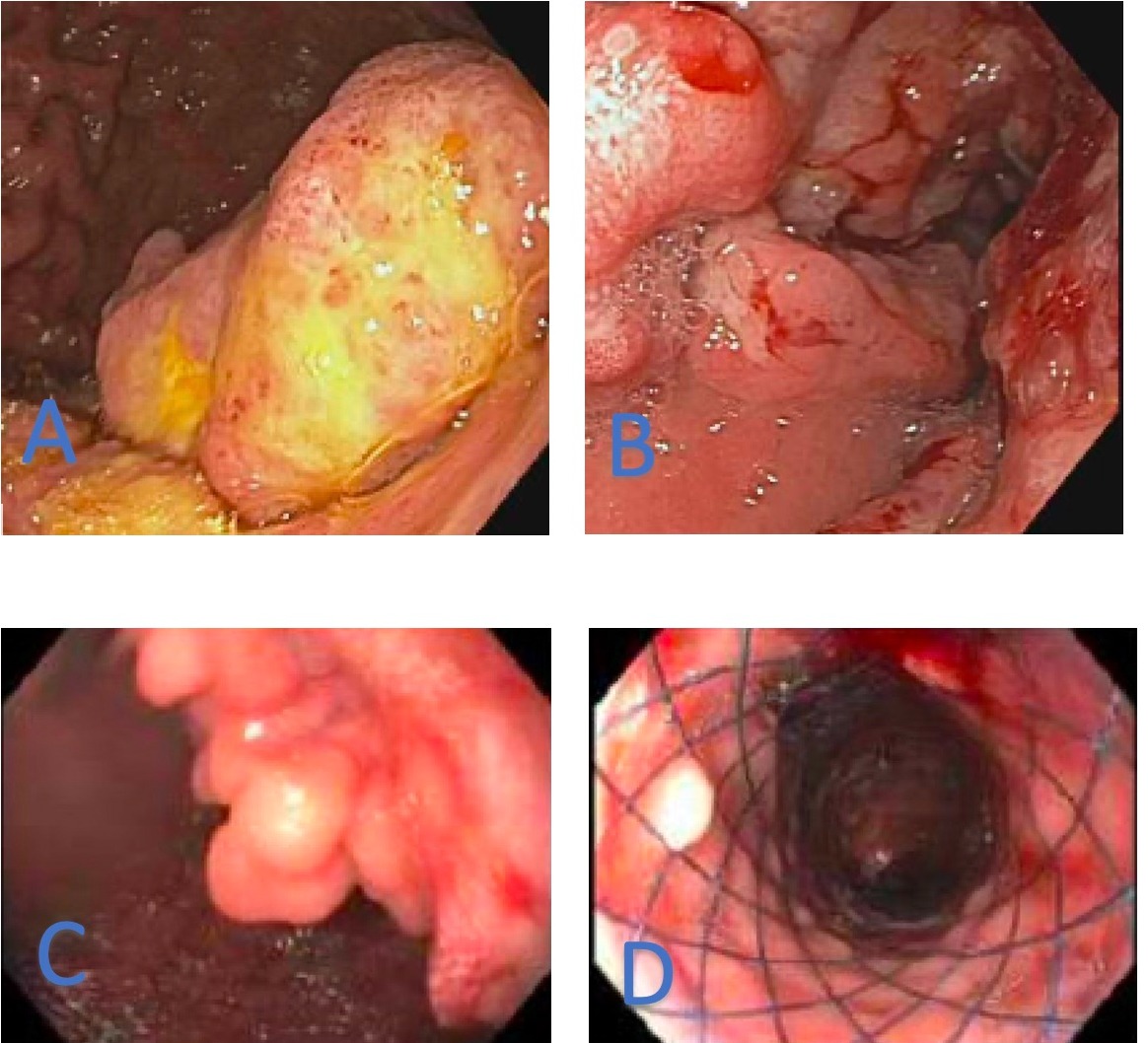Sunday Poster Session
Category: Stomach
P1366 - Primary Gastric Squamous Cell Carcinoma: A Once in a Lifetime Diagnosis
Sunday, October 22, 2023
3:30 PM - 7:00 PM PT
Location: Exhibit Hall

Has Audio

Mary Alexandra Bramlage, MD
Atrium Health Carolinas Medical Center
Charlotte, NC
Presenting Author(s)
Mary Alexandra Bramlage, MD1, Jessica Sang, MD2, Jason Lewis, MD2
1Atrium Health Carolinas Medical Center, Charlotte, NC; 2Atrium Health, Charlotte, NC
Introduction: Primary gastric squamous cell carcinoma (PGSCC) is an exceptionally rare diagnosis. There have only been approximately 100 human cases of PGSCC published in literature. Given the rarity of this diagnosis, treatment strategies remain controversial.
Case Description/Methods: A 55-year-old male with history of tobacco and alcohol use presented with 55 lb weight loss, hiccups, early satiety, nausea, and vomiting over the preceding 5 months. A CT scan revealed a lobulated, hyper-enhancing fold and wall thickening of the gastric body along with gastrohepatic and peripancreatic adenopathy. His PET scan showed extensive hypermetabolic wall thickening in the stomach consistent with the clinical diagnosis of gastric cancer. During EGD, a large fungating and ulcerated mass was found on the greater curvature of the stomach and on the posterior wall of the stomach. Biopsies revealed poorly differentiated squamous cell carcinoma. A port and J tube were placed and he underwent chemotherapy including FOLFOX (folinic acid, 5-fluorouracil, and oxaliplatin) and nivolumab. He was noted to have clinical improvement based on weight gain. He completed 6 cycles of FOLFOX and nivolumab, then was transitioned to 5-fluorouracil and nivolumab for maintenance.
Sixteen months later, he returned with abdominal pain and dehydration. Imaging found the gastric mass to now be involving the body of the pancreas as well as the transverse mesocolon. He underwent palliative radiation and EUS. Pancreatic biopsies taken during EUS found squamous cell carcinoma within the pancreatic parenchyma.
One month later, he returned no longer tolerating oral intake. EGD revealed a malignant-appearing, intrinsic moderate stenosis at the pylorus. This was traversed and a stent was placed. He was transitioned to hospice care and passed away the following month.
Discussion: Given the rarity of PGSCC, there is no consensus on how to best approach treatment. One retrospective analysis found the median survival time for patients who underwent resection of the cancer vs those who did not was 46 vs 4.5 months, respectively.1
This patient did not undergo gastrectomy. He survived 18 months after his initial diagnosis.
Further data and larger case series will be needed in order to identify the best treatment options for patients with PGSCC.
Chen Y et al. Clinicopathological Characteristics, Treatment, and Prognosis of 21 Patients with Primary Gastric Squamous Cell Carcinoma. Gastroenterol Res Pract. 2016;2016:3062547. doi: 10.1155/2016/3062547.

Disclosures:
Mary Alexandra Bramlage, MD1, Jessica Sang, MD2, Jason Lewis, MD2. P1366 - Primary Gastric Squamous Cell Carcinoma: A Once in a Lifetime Diagnosis, ACG 2023 Annual Scientific Meeting Abstracts. Vancouver, BC, Canada: American College of Gastroenterology.
1Atrium Health Carolinas Medical Center, Charlotte, NC; 2Atrium Health, Charlotte, NC
Introduction: Primary gastric squamous cell carcinoma (PGSCC) is an exceptionally rare diagnosis. There have only been approximately 100 human cases of PGSCC published in literature. Given the rarity of this diagnosis, treatment strategies remain controversial.
Case Description/Methods: A 55-year-old male with history of tobacco and alcohol use presented with 55 lb weight loss, hiccups, early satiety, nausea, and vomiting over the preceding 5 months. A CT scan revealed a lobulated, hyper-enhancing fold and wall thickening of the gastric body along with gastrohepatic and peripancreatic adenopathy. His PET scan showed extensive hypermetabolic wall thickening in the stomach consistent with the clinical diagnosis of gastric cancer. During EGD, a large fungating and ulcerated mass was found on the greater curvature of the stomach and on the posterior wall of the stomach. Biopsies revealed poorly differentiated squamous cell carcinoma. A port and J tube were placed and he underwent chemotherapy including FOLFOX (folinic acid, 5-fluorouracil, and oxaliplatin) and nivolumab. He was noted to have clinical improvement based on weight gain. He completed 6 cycles of FOLFOX and nivolumab, then was transitioned to 5-fluorouracil and nivolumab for maintenance.
Sixteen months later, he returned with abdominal pain and dehydration. Imaging found the gastric mass to now be involving the body of the pancreas as well as the transverse mesocolon. He underwent palliative radiation and EUS. Pancreatic biopsies taken during EUS found squamous cell carcinoma within the pancreatic parenchyma.
One month later, he returned no longer tolerating oral intake. EGD revealed a malignant-appearing, intrinsic moderate stenosis at the pylorus. This was traversed and a stent was placed. He was transitioned to hospice care and passed away the following month.
Discussion: Given the rarity of PGSCC, there is no consensus on how to best approach treatment. One retrospective analysis found the median survival time for patients who underwent resection of the cancer vs those who did not was 46 vs 4.5 months, respectively.1
This patient did not undergo gastrectomy. He survived 18 months after his initial diagnosis.
Further data and larger case series will be needed in order to identify the best treatment options for patients with PGSCC.
Chen Y et al. Clinicopathological Characteristics, Treatment, and Prognosis of 21 Patients with Primary Gastric Squamous Cell Carcinoma. Gastroenterol Res Pract. 2016;2016:3062547. doi: 10.1155/2016/3062547.

Figure: A) Large fungating and ulcerated mass of greater curvature of stomach and B) posterior wall of stomach
C) Malignant-appearing, intrinsic moderate stenosis at the pylorus D) The stenosis was traversed and a stent was placed
C) Malignant-appearing, intrinsic moderate stenosis at the pylorus D) The stenosis was traversed and a stent was placed
Disclosures:
Mary Alexandra Bramlage indicated no relevant financial relationships.
Jessica Sang indicated no relevant financial relationships.
Jason Lewis indicated no relevant financial relationships.
Mary Alexandra Bramlage, MD1, Jessica Sang, MD2, Jason Lewis, MD2. P1366 - Primary Gastric Squamous Cell Carcinoma: A Once in a Lifetime Diagnosis, ACG 2023 Annual Scientific Meeting Abstracts. Vancouver, BC, Canada: American College of Gastroenterology.
